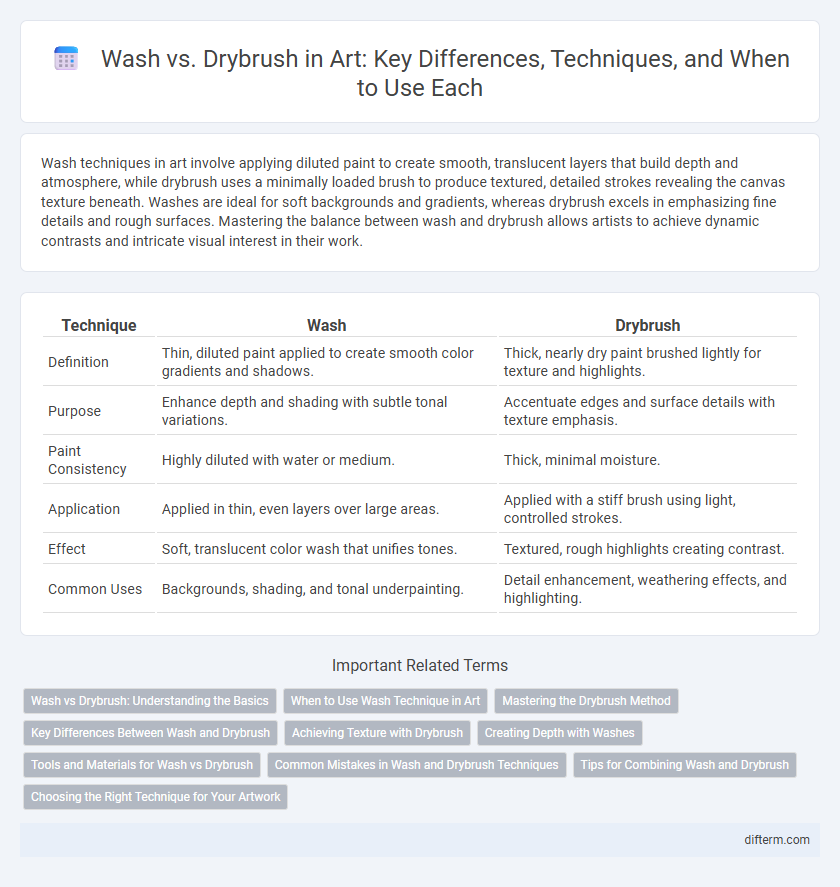Wash techniques in art involve applying diluted paint to create smooth, translucent layers that build depth and atmosphere, while drybrush uses a minimally loaded brush to produce textured, detailed strokes revealing the canvas texture beneath. Washes are ideal for soft backgrounds and gradients, whereas drybrush excels in emphasizing fine details and rough surfaces. Mastering the balance between wash and drybrush allows artists to achieve dynamic contrasts and intricate visual interest in their work.
Table of Comparison
| Technique | Wash | Drybrush |
|---|---|---|
| Definition | Thin, diluted paint applied to create smooth color gradients and shadows. | Thick, nearly dry paint brushed lightly for texture and highlights. |
| Purpose | Enhance depth and shading with subtle tonal variations. | Accentuate edges and surface details with texture emphasis. |
| Paint Consistency | Highly diluted with water or medium. | Thick, minimal moisture. |
| Application | Applied in thin, even layers over large areas. | Applied with a stiff brush using light, controlled strokes. |
| Effect | Soft, translucent color wash that unifies tones. | Textured, rough highlights creating contrast. |
| Common Uses | Backgrounds, shading, and tonal underpainting. | Detail enhancement, weathering effects, and highlighting. |
Wash vs Drybrush: Understanding the Basics
Wash and drybrush are essential painting techniques that create different visual textures and effects. Wash involves applying thinned, transparent paint layers to achieve smooth color gradients and subtle shading, making it ideal for backgrounds and large surfaces. Drybrush uses a minimally loaded, dry brush to apply paint, producing rough, textured strokes that highlight details and create depth on raised surfaces.
When to Use Wash Technique in Art
Use the wash technique in art to create smooth, translucent layers that build depth and subtle color gradients, ideal for backgrounds and atmospheric effects. This method works best on watercolor paper or canvas with water-based paints like watercolors or thinned acrylics, allowing pigments to flow freely and blend seamlessly. Washes help establish mood and tonal variation without harsh brushstrokes, making them suitable for initial layers or delicate transitions in a composition.
Mastering the Drybrush Method
Mastering the drybrush method involves using a small amount of paint on a dry brush to create textured, detailed effects that enhance depth and realism in artwork. Unlike washes, which rely on diluted pigments for smooth, translucent layers, drybrushing allows artists to emphasize highlights and surface textures with precision. This technique is essential for adding dimension and intricate details, particularly in miniature painting, landscapes, and character portraits.
Key Differences Between Wash and Drybrush
Wash techniques involve applying diluted paint to create translucent layers, enhancing depth and subtle color gradients, while drybrush uses a minimally loaded brush to produce textured, precise strokes emphasizing surface details. Wash is ideal for backgrounds and large areas with soft transitions, whereas drybrush excels at highlighting fine details and creating rough, tactile effects on textured surfaces. Understanding these differences allows artists to effectively combine both methods to achieve varied visual dynamics in their paintings.
Achieving Texture with Drybrush
Drybrush technique in painting achieves texture by applying a small amount of pigment on a dry brush, creating a rough, scratchy effect that reveals underlying layers and surface variations. Unlike washes, which produce smooth, translucent color transitions, drybrush emphasizes surface details and enhances dimensionality in artworks. This method is ideal for rendering tactile elements such as fabric fibers, wood grain, and weathered surfaces, providing a rich, textured visual experience.
Creating Depth with Washes
Washes create depth by applying diluted paint in transparent layers, allowing colors to blend subtly and build atmospheric effects in paintings. This technique enhances shadows and gradients, producing a smooth transition that mimics natural light and tonal variation. Unlike dry brushing, washes provide a fluid, soft texture ideal for backgrounds and large areas requiring seamless color shifts.
Tools and Materials for Wash vs Drybrush
Wash techniques typically require diluted watercolors or inks applied with soft brushes to create smooth, transparent layers, emphasizing fluidity and blending. Drybrush methods use stiff-bristled brushes with minimal paint, often acrylic or oil, allowing for textured, controlled strokes that highlight surface details. Both techniques demand specific paper types: absorbent and smooth for washes, textured and heavier for drybrush to maximize pigment retention and brush impact.
Common Mistakes in Wash and Drybrush Techniques
Common mistakes in wash techniques include applying overly diluted paint that results in a patchy or streaky finish and insufficient surface preparation causing uneven pigment absorption. In drybrush techniques, errors often stem from using too much paint or pressure, which eliminates the intended texture and fine detail effects. Mastering consistent layer control and brush handling significantly improves the quality and realism of both wash and drybrush applications.
Tips for Combining Wash and Drybrush
Achieving depth and texture in artwork involves mastering the balance between wash and drybrush techniques for optimal visual impact. Use a wash to lay down smooth, transparent layers of color, then apply drybrush strokes to highlight edges and add intricate details for enhanced dimensionality. Allow each layer to fully dry before combining to prevent unwanted blending, ensuring a crisp, layered effect that leverages the strengths of both methods.
Choosing the Right Technique for Your Artwork
Choosing between wash and drybrush techniques depends on the desired texture and mood of the artwork. Wash creates smooth gradients and translucent layers ideal for backgrounds and soft shadows, while drybrush offers rough, textured strokes perfect for detailed highlights and expressive effects. Understanding how each method interacts with paint and surface enhances artistic control and depth in your compositions.
wash vs drybrush Infographic

 difterm.com
difterm.com